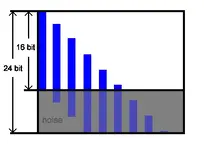Good point barefoot about higher bit depths not "improving the original sound". I suspect that people think that is the case sometimes...

Higher bit depth just means that any "hash" from quantiniztion errors that WILL happen from even a .1dB of boost/cut in level from the original data.
Think of it this way. The data is "stacked" so to speak. Digital only reflects a % of all volumes that are possible, so there has to be known volume levels to store the digital data. Digital is that way. I wants to KNOW what to do with something. It is not a living breathing thing!

So, when you record, the volume steps are defined. Whether the converter did it well or not, with dithering or not, what you have is what you have. Cool.
The problem starts with boosting/cutting levels in ANY way. EQ tweeks are a form of level adjustment because in fact you ARE boosting/cutting the overall volume of a recorded track when you apply eq to it. Makes sense right? Cool. But with a digital audio, this means that when you create the "new" digital audio, which is "post DSP", how the volume steps needs to be redone. Now your audio is subject to coding of the software application. It may or may not do such a hot job of created new "good" data. But it is what it is. The real kicker though is that the resulting "post DSP" data will not fit neatly into the fixed values that can be stored for the bit resolution you are working at, thus, you will be creating MORE quantinization errors from the recalibration of the levels. This adversely effects the last bit or two or three, while it usually isn't too noticeable at the most significant bits. So, your low level information starts to become corrupt. Okay, most realize this is the case.
What higher bit resolution gives you is the opportunity to move those quantinization errors down to bit levels that our hears are not sensitive enough to hear. Our hearing range has a rough "bit equivelent" of about 21 bits. So, if quantinization errors are only obvious to the least 2 or 3 significant bits, then those errors would be low enough so that our ears don't HEAR them, thus, DSP free of Q errors!!!! Very cool!!!
Now, how dithering comes into play is that dithering adds a bit of noise at a certain level. Waaaaaaaaaaaaaaaaaay down there in volume. It applies it to the least significant bit. It keeps that least significant bit to ON! Thus, a few more bits of data is possible to store to 16 bit, because the audio data is COMBINED with the dithering data. So even though the audio is lower in volume than the dithering noise, the dithering noise is SHAPED NOISE and you can hear or sounds that are lower in volume than it, because the frequency that shaped noise is at is out of the ears ultra sensitivity range ( around 2-7KHz....) So, lower level stuff STILL retains dynamics because it CAN, because it doesn't require bit depth to represent values, because the lowest bit is always on and there is some noise there to blend with it. Sound weird, but that is what happens, and it WORKS.
Ed




